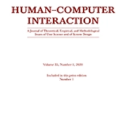Internet of Things (IoT) devices have become prevalent, embedding intelligence into our environment. It is projected that over 75 billion IoT devices will be connected by 2025 worldwide, with the majority being operated indoors. Dye-sensitized solar cells (DSSC) have recently been optimized for ambient light, having the capabilities of providing sufficient energy for self-powered IoT devices. Interaction with digital technologies, termed Human Computer Interaction (HCI), is often achieved via physical mechanisms (e.g. remote controls, cell phones) which can hinder the natural interface between users and IoT devices, a key consideration for HCI. What if the solar cell that is powering the IoT device can also recognize hand gestures which would allow the user to naturally interact with the system? Previous attempts to achieve this have necessarily employed an array of solar cell/photodiodes to detect directionality. In this work, we demonstrate that by monitoring the photocurrent output of an asymmetrically patterned monolithic (i.e., single cell) DSSC, and using machine learning, we can recognize simple hand gestures, achieving an accuracy prediction of 97.71%. This work shows that, DSSCs are the perfect choice for self-powered interactive technologies, both in terms of powering IoT devices in ambient light conditions and having aesthetic qualities that are prioritized by users. As well as powering interactive technologies, they can also provide a means of interactive control.
翻译:暂无翻译



